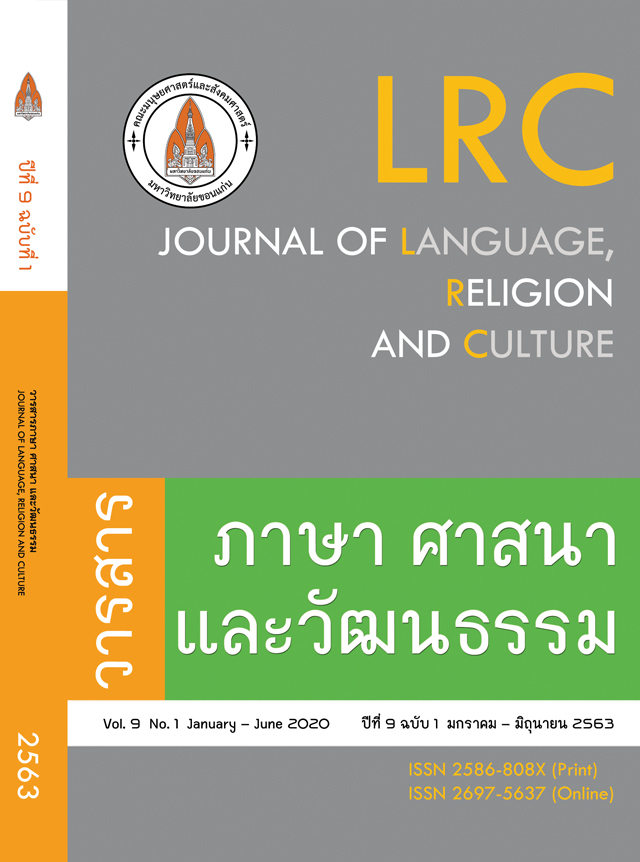The Chinese word “Meaning” (意思) in Pragmatic Enrichment ; การศึกษาความหมายของคำศัพท์ภาษาจีน “ความหมาย” เชิงวัจนปฏิบัติศาสตร์
Keywords:
ภาษาจีน, คำศัพท์ภาษาจีนความหมาย, วัจนปฏิบัติศาสตร์, Chinese language, Chinese word meaning (意思), Pragmatic EnrichmentAbstract
บทคัดย่อ
ในบริบทที่แตกต่างกัน คำศัพท์ภาษาจีน "ความหมาย" สามารถทำให้ผู้ฟังมีความเข้าใจแตกต่างจากความหมายเดิมของคำศัพท์นี้ได้เพราะในความหมายของคำศัพท์ "ความหมาย" ไม่สามารถแสดงความหมายที่แน่นอนโดยปราศจากบริบทของประโยคนั้นๆได้ ซึ่งอาจกล่าวได้ว่าคำศัพท์ “ความหมาย” คือคำที่สามารถมีความหมายแตกต่างจากความหมายเดิมเพราะนี่คือความไม่แน่นอนของธรรมชาติของภาษา
บทความวิชาการเรื่องนี้เป็นบทความที่กล่าวถึงความหมายและการเสริมสร้างความสามารถในการใช้และเข้าใจคำศัพท์ภาษาจีนคำว่า "ความหมาย" ในบริบทที่แตกต่างกันโดยอาศัยทฤษฎีวัจนปฏิบัติศาสตร์ซึ่งเป็นการศึกษาวิธีการใช้ถ้อยความเป็นพื้นฐานในการทำความเข้าใจความหมายของคำศัพท์คำนี้ วัจนปฏิบัติศาสตร์ประกอบไปด้วย การจำกัดขอบเขตความหมายของวัจนปฏิบัติศาสตร์ การขยายขอบเขตความหมายของวัจนปฏิบัติศาสตร์ และการขยายหมวดหมู่ของต้นแบบของความหมายคำของวัจนปฏิบัติศาสตร์
จากบทความเรื่องนี้สามารถสรุปได้ว่า ไม่ว่าคำศัพท์ภาษาจีนคำว่า "ความหมาย" จะมีความหมายของคำที่มากเท่าไรก็ตาม ในทางด้านภาษาที่ใช้ในการสื่อสารนั้นจะยังคงสามารถเลือกและเข้าใจความหมายของการสื่อสารตามข้อมูลที่ได้รับในบริบทเฉพาะ ซึ่งแสดงให้เห็นว่า ในการใช้ถ้อยความเพื่อสื่อความหมายในการสื่อสารทางภาษาไม่ว่าจะแบบใดก็ตาม สิ่งที่สำคัญที่สุดไม่ใช่ความหมายของคำศัพท์เดิม แต่เป็นความหมายที่ดีที่สุดในการทำความเข้าใจในข้อมูลของสารจากภาษาที่ได้รับในบริบทเฉพาะ
Abstract
In different contexts, the Chinese word “meaning” (意思) makes listener’s understanding different from original meaning because in lexical pragmatics the word “meaning” cannot express the exact meaning without context-dependent; it means this word is indeterminacy of natural language.
This article discusses the meaning and Pragmatic Enrichment of the Chinese word “meaning” (意思) in difference contexts, and each meaning will be context-based pragmatically enriched. Pragmatic Enrichment includes Pragmatic Narrowing, Pragmatic Broadening, and Prototype Category Extension of a word. According to the article, the different meanings of "meaning" shows that no matter how many meanings a word has, in language communication it can only select and understand the linguistic information based on the context.
All in all, in language communication, the most important thing is not the lexical meaning of a word, but the best meaning of understanding linguistic information in a specific context.
References
Guo, T. (2018). Shi yi lilun xia de kouyi yuyong chongshi tanxi [On Pragmatic
Enrichment in Interpretation under Interpretative Theory]. Journal of Hunan
First Normal College, 18(02), 105-109.
Liu, W. (2014). Yi ci duo yi yu yuyong chongshi [A Pragmatic Enrichment. Study
of Polysemy]. Cai Zhi, 28, 285.
Ran, Y. (2012). New Explorations in Lexical Pragmatics. Beijing: Foreign Language
Teaching and Research Press.
Sequeiros, XR. (2002). Interlingual Pragmatic Enrichment. in translation. Journal
of Pragmatics, 34, 1069-1089.
Wilson, D. (2004). Relevance, word meaning and communication: The Past, Present
and Future of Lexical Pragmatics. Modern Foreign Languages (Quarterly),
, 1-13.
Wu, D. (2016). Jiyu yuyong shiyi kan xuexi cidian zhong duo yici de bu queding xing
-–yi “yisi” he “mean” wei ge an fenxi [Looking at the Uncertainty
of Polysemous Words in the Learner’s Dictionary Based on Pragmatic
Interpretation--A Case Study of “meaning” and “mean”]. Modern Chinese
(Language Research Edition), 12, 37-41.







